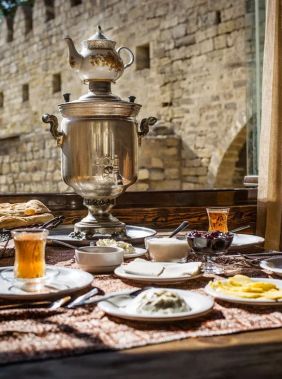
From traditional bistros serving local delicacies to chic Western-style restaurants, Baku offers diverse dining experiences to tickle all travellers’ taste buds. You’ll find plenty of places to sample the best of Azerbaijani cuisine, alongside a growing mix of popular international franchises, contemporary cafes, caravanserais, chocolate shops and steakhouses.
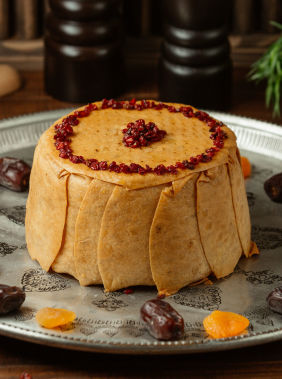
Ganja blends an ancient history and youthful energy, but it is no less interesting from a culinary perspective – the region has several of its own special desserts and dishes. Unlike its Baku counterpart, Ganja’s version of pakhlava is lighter in colour and baked on a copper tray over a campfire. It’s extremely tender and has a taste exuding hints of roses and saffron that melt in your mouth. Of the region’s other specialties, during a trip to Ganja don’t miss trying: Ganja dovga, a yoghurt-based soup with herbs and veg such as mint, spinach and celery; keta which are meat or herb qutabs with white cheese; and of course, shah (king) pilaf, a rice dish resembling a massive pie packed with meat, dried fruit and onions and baked with a covering of lavash flatbread.
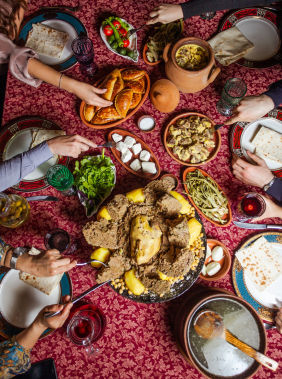
Ask Azerbaijanis about Nakhchivan and we’ll often think of its distinct cuisine, which is packed with fresh herbs, fruits, vegetables and lamb. One local lamb stew, qovurma shorbasi, served with beans, potatoes and a poached egg on top, is still cooked and stored according to ancient tradition: underground in earthenware pots. Another popular lamb dish is the imaginatively named dadli qala (‘delicious fortress’): ribs cooked inside a tandoor oven and served with buckwheat, roast potatoes and tomatoes. Ordubad, a town in the east of the region, is known for its puffy omelettes soaked in honey and its bountiful orchards producing figs, apricots, peaches and pears. Even our most delicious lemons come from Ordubad! All of these fruits are then dried for winter and sold in Nakhchivan’s bustling local bazaar – another place well worth visiting.

Lankaran’s local cuisine is rich and diverse: rice, meat, fish, vegetables and mouth-watering sweets are staples of this region in the subtropical south spread between the Talysh Mountains and the Caspian Sea. The area is diverse and multicultural, with the large Talysh population giving their own interesting twist to traditional Azerbaijani cuisine. The most famous local dish is lavangi, which is made of chicken or fish stuffed with nuts, onions and sumakh and cooked in the cylindrical clay tandir oven traditionally used to bake delicious tandir bread. Other dishes worth trying are kulcha, local lentil and pumpkin pilafs and turshu kebab. Vegetarians should check out kükü, an omelette filled with onions and herbs and served with soft, thin lavash flatbread.
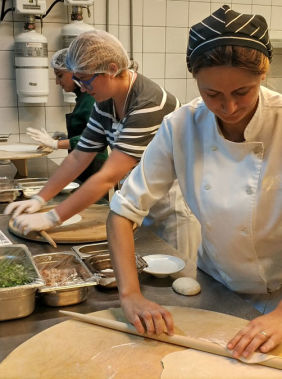
For an authentic taste of the Caucasus Mountains, nowhere beats Gusar in the north-east. This region is largely populated by Lezgis, a mountain people with their own special take on traditional Azerbaijani cuisine. With the help of the kharak, a traditional Lezgi bread-making oven, the local people make an astonishing variety of flatbreads, including a local type of pizza called shakuka. Another dish not to miss is a traditional meat pie called tskan. And whatever you try here, it will be sure to be packed with fragrant herbs and berries foraged from the lush forests that carpet the surrounding mountains. You can tuck into all this at local restaurants in Gusar city and its surrounds. To find the top spots, ask the locals!
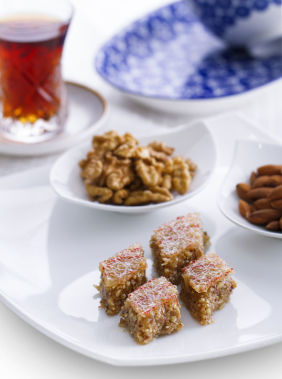
Sheki’s residents are renowned for their sweet tooth and anyone visiting Sheki mustn’t miss visiting local sweet shops. The city’s most famous sweet is halva, a local variation of pakhlava made of layers of rice dough lattices stuffed with ground nuts, syrup, spices and saffron. Neatly wrapped boxes of halva make a great gift to take home, but why not try your hand at making some? Several traditional sweet shops in town offer halva-making masterclasses with local pastry chefs unravelling closely kept family recipes dating back hundreds of years.
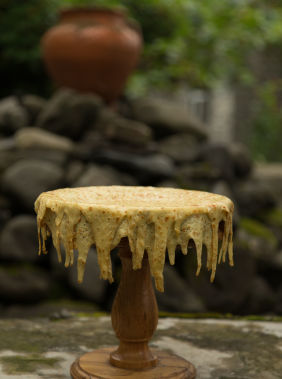
The villages of the far north-western corner of Azerbaijan, encompassing the regions of Gakh, Zagatala and Balaken, are blessed with verdant gardens brimming with hazelnuts and persimmons. So abundant are they that the harvests of both are celebrated annually: each autumn the Hazelnut Festival takes place in Zagatala while Balaken hosts the Persimmon Festival. The mountainous areas of Gakh, meanwhile, are known for their use of dried meat. One dish is particularly famous: surhullu, a hearty meal made of pieces of dough topped with meat that’s been left out to dry over winter. A great place to try it is in the region’s highest village – Saribash. Other culinary features of the north-west are the use of roses to make jams and rose water and the wonderful wild honey produced in the foothills of the Caucasus Mountains.

Some local restaurants in Baku, especially in the Old City, offer impromptu masterclasses teaching you how to make one of the city’s favourite snacks: gutabs. While these generally need to be organised through private guides, it may also be possible to simply wander into restaurants (such as Salam Baku, Cizz-Bizz, Old House and Passage 1901) and ask. Most will allow you to join in, letting you have a go at stuffing and wrapping the qutabs before placing them in a traditional tandir oven.
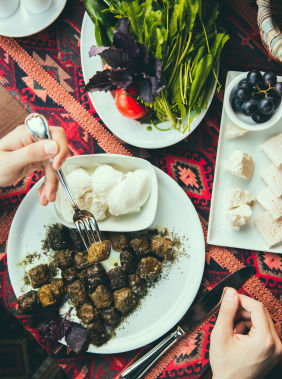
Besides being one of the most unique places to stay in northern Azerbaijan, Sheki’s Karvansaray, a 18th-century caravanserai converted into a hotel, also occasionally hosts masterclasses in making dolma, one of Azerbaijan’s most popular dishes made usually of grape leaves stuffed with a filling of meat, rice, herbs and nuts, with many variations around the country. Sheki’s special version of dolma involves cooking the dolma pieces in the city’s signature clay pots called "dopu".
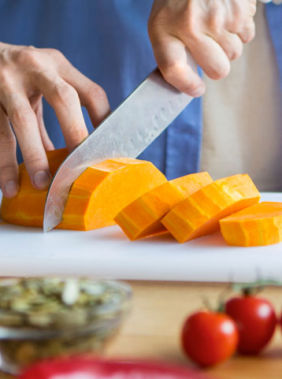
From its tea to its tandir bread, Lankaran is undoubtedly one of the tastiest corners of Azerbaijan. Travelling here will give the opportunity to savour fish from the Caspian Sea and honey from the Hirkan Forest, as well as quintessential dishes inspired by the local Talysh people, such as chicken or fish lavangi and pumpkin pilaf, both of which you can learn to cook yourselves at masterclasses offered by some local restaurants.